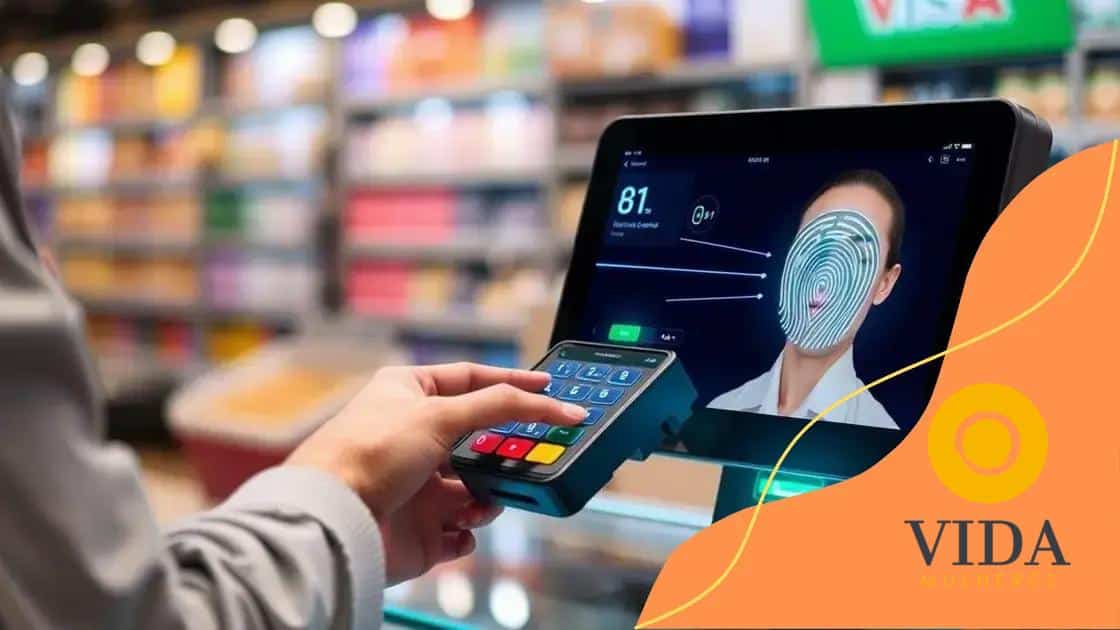Payment processing firms adapt to biometric authentication

Payment processing firms adapt to biometric authentication to enhance security, streamline transactions, and meet growing consumer demand for convenient payment methods, while also navigating challenges like privacy and regulatory compliance.
Payment processing firms adapt to biometric authentication as a response to growing security concerns. Have you ever thought about how these technologies could make your transactions safer and more seamless? In this article, we delve into the changes that are transforming the payment landscape.
The rise of biometric authentication
Biometric authentication is becoming increasingly popular in various sectors, especially in payment processing. This technology uses unique physical characteristics, like fingerprints and facial recognition, to verify a person’s identity. As customers seek safer transactions, payment processing firms realize the importance of incorporating biometric solutions.
The increasing demand for security
With cybersecurity threats on the rise, traditional methods like passwords are no longer sufficient. Biometric systems offer a stronger layer of security that is difficult to replicate or steal. They help in preventing fraud and protecting sensitive information.
Key benefits of biometric authentication
- Increased security through unique user traits
- Faster transaction processes, enhancing customer experience
- Reduced risk of identity theft and fraud
- Convenience for users who prefer seamless transactions
These benefits showcase why biometric systems are gaining traction. Customers appreciate the convenience this technology brings, allowing for quicker and more secure payments. As more businesses adopt these methods, the trend is likely to continue evolving.
Moreover, the technology is becoming more accessible. With advancements in smartphones incorporating fingerprint and facial recognition, everyday consumers are becoming familiar with biometric solutions. This familiarity encourages greater acceptance, making it easier for firms to transition.
Challenges to overcome
Despite the advantages, there are challenges that payment processing firms face when implementing biometric authentication. Privacy concerns are a primary issue, as customers may be hesitant to share their biometric data. Additionally, technological limitations can hinder the effectiveness of these systems if not adapted properly.
Ultimately, the rise of biometric authentication is reshaping how we conduct transactions. As technology progresses and security becomes a priority, this method is set to become a standard in payment processing, changing the way we view our security in financial transactions.
Key benefits for payment processing firms

Payment processing firms that adopt biometric authentication gain numerous advantages. This technology not only enhances security but also improves the overall transaction experience. By leveraging biometric solutions, companies can stay ahead in the competitive payment landscape.
Enhanced security measures
One of the most significant benefits is the increased security it provides. Biometric authentication systems, such as fingerprint scanning and facial recognition, are harder to spoof than traditional methods. This added layer of protection helps in significantly reducing fraud.
Improved customer experience
Customers prefer quick and efficient payment methods. By using biometric systems, transactions become faster and more seamless. Users no longer need to remember passwords or PINs; instead, they can confirm their identity with a simple touch or glance.
- Faster checkouts with minimal friction
- Higher customer satisfaction due to convenience
- Reduced waiting times at payment terminals
These factors contribute to a better overall experience for customers. As they enjoy a smoother process, they are likely to return to businesses that use this technology.
Cost savings in the long run
While the initial investment in biometric technology may seem high, the long-term benefits often outweigh the costs. Payment processing firms can reduce losses from fraudulent transactions and minimize the expenses associated with chargebacks. Over time, the technological shift can lead to significant cost savings.
Furthermore, as more businesses opt for biometric systems, operational efficiencies improve, allowing firms to redirect resources to other vital areas. Customers are enablers of this shift, eagerly embracing technology that protects their financial information.
The seamless integration of biometric authentication into payment processes positions companies for growth and success. Firms that prioritize security and convenience not only attract more customers but also retain them for longer periods.
Challenges in implementing biometric security
Implementing biometric security in payment processing comes with several challenges. Although the benefits are clear, companies must navigate these obstacles effectively. One major concern is privacy. Customers are often wary about sharing their biometric data, fearing misuse or breaches.
Privacy and security concerns
People want assurance that their sensitive information will be protected. Mismanagement of this data can lead to significant trust issues for firms. To mitigate these concerns, companies must prioritize transparency and actively communicate how data is collected and used.
Technological limitations
An additional challenge is the technology itself. Some biometric systems may not be as reliable as anticipated. Factors like environmental settings can affect performance, leading to false rejections or failures in identifying authorized users. This inconsistency can frustrate customers.
- Weather conditions can affect fingerprint readers
- Lighting issues may impact facial recognition
- Hardware costs can be prohibitive for smaller firms
These technological challenges create barriers to implementation. It’s essential for firms to invest in quality systems and test them thoroughly to achieve reliable performance.
Regulatory compliance
Another layer of complexity comes from regulatory compliance. Different regions have varying laws regarding the collection and storage of biometric data. Payment processing firms must ensure they comply with these regulations, which can be a daunting task, especially in a global market.
Organizations may require legal expertise to navigate these regulations and avoid potential fines. Companies must create policies that align with regulatory standards while still providing users with convenient experiences.
In summary, while biometric security presents promising advancements in payment processing, challenges such as privacy, technology limitations, and regulatory compliance need careful consideration. Meeting these challenges head-on is vital for the successful integration of biometric technology in the payment landscape.
Consumer perspectives on biometric transactions
Consumer perspectives on biometric transactions are vital in understanding how this technology is received in the market. Many people appreciate the enhanced security offered by biometric authentication. They feel more protected against fraud compared to traditional methods.
Trust in biometric systems
The level of trust consumers have in these systems significantly affects their willingness to use them. When customers understand that their biometric data is securely stored and processed, they are more likely to embrace this technology. This trust can be built through transparency in how companies handle their information.
Convenience of biometric payments
Another key perspective is the convenience that biometrics provide. Many customers dislike remembering passwords and PINs. With biometric systems, users can complete transactions quickly, often with just a fingerprint or facial recognition. This speed is appealing to those who lead busy lifestyles.
- Quick payments lead to shorter checkout times
- Less hassle managing multiple passwords
- Improved shopping experience overall
As customers experience these benefits, their positive perspectives increase. They associate biometric transactions with efficiency and ease, which can lead to higher customer satisfaction.
Concerns about privacy and security
However, there are still concerns from customers regarding privacy. Some individuals fear that their biometric information might be misused or fall into the wrong hands. To address this, businesses must assure consumers that their data is handled with the utmost care and complies with relevant laws.
Education plays a crucial role here. Companies can share information on the measures they take to protect biometric data, helping to alleviate fears and build consumer confidence. Engaging with customers through surveys and feedback can also provide insights into their preferences and concerns.
In conclusion, understanding consumer perspectives on biometric transactions will help payment processing firms adapt their strategies to boost adoption and create a secure, user-friendly experience.
Future trends in payment processing technology
The future of payment processing technology is changing rapidly, with many new trends emerging. Businesses must keep up to remain competitive. One significant trend is the rise of mobile payments. As more people use smartphones, mobile transactions are becoming the norm.
Growth of contactless payments
Contactless payment methods are also gaining popularity. Customers appreciate the convenience of tapping their cards or phones to make purchases. This reduces transaction time and enhances the shopping experience overall.
Integration of blockchain technology
Blockchain technology is poised to disrupt the payment processing landscape. It offers increased security and transparency by recording transactions on a decentralized ledger. This innovation can help prevent fraud and provide better tracking of payment histories.
- Lower transaction fees for merchants
- Faster international transactions
- Improved security through encryption
As businesses begin to understand the benefits of blockchain, more will look to integrate it into their systems. This will pave the way for innovations such as smart contracts and decentralized finance.
Artificial intelligence in payment processing
Another significant trend is the use of artificial intelligence (AI). AI systems can help analyze transaction data, identify patterns, and detect fraud in real-time. This technology can adapt to threats, making transactions safer for consumers and businesses alike.
Customer service is also enhanced through AI chatbots. They can address customer queries regarding transactions instantly, improving customer satisfaction while reducing operational costs.
Overall, the landscape of payment processing technology is evolving quickly. Adopting these trends will help businesses stay ahead and provide better experiences for their customers.
FAQ – Frequently Asked Questions about Payment Processing and Biometric Authentication
What are the main benefits of using biometric authentication in payment processing?
Biometric authentication enhances security, speeds up transactions, and improves the overall customer experience by providing a more convenient payment method.
How does mobile payment technology impact consumers?
Mobile payment technology allows consumers to make fast and secure payments using their smartphones, reducing checkout times and improving convenience.
What challenges do businesses face when implementing biometric systems?
Businesses may face privacy concerns, technological limitations, and regulatory compliance issues when integrating biometric authentication into their payment processes.
What future trends should businesses watch in payment processing technology?
Businesses should keep an eye on mobile payments, blockchain technology, and artificial intelligence as these trends are set to reshape how transactions are processed.






